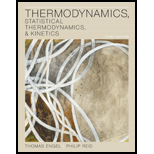
Thermodynamics, Statistical Thermodynamics, & Kinetics
3rd Edition
ISBN: 9780321766182
Author: Thomas Engel, Philip Reid
Publisher: Prentice Hall
expand_more
expand_more
format_list_bulleted
Question
Chapter 3, Problem 3.30NP
Interpretation Introduction
Interpretation:
Starting with
Concept Introduction :
Specific heat could be explained as the quantity of heat needed in order to increase the temperature by 10C. From the given relation
Here,
Expert Solution & Answer
Want to see the full answer?
Check out a sample textbook solution
Students have asked these similar questions
One step of glycolysis is a retro-aldol reaction (aldolase) to produce ATP.Below is the aldol reaction of the equilibrium. Show the mechanism for the base catalyzed reaction. *see image
Provide the missing information. *see image
Why does the following reaction lead to poor yields? Correct the reaction. *see image
Chapter 3 Solutions
Thermodynamics, Statistical Thermodynamics, & Kinetics
Ch. 3 - Prob. 3.1CPCh. 3 - Prob. 3.2CPCh. 3 - Prob. 3.3CPCh. 3 - Prob. 3.4CPCh. 3 - Why can qv be equated with a state function if q...Ch. 3 - Prob. 3.6CPCh. 3 - Prob. 3.7CPCh. 3 - Prob. 3.8CPCh. 3 - Prob. 3.9CPCh. 3 - Why is qv=U only for a constant volume process? Is...
Ch. 3 - Prob. 3.11CPCh. 3 - Why are q and w not state functions?Ch. 3 - Prob. 3.13CPCh. 3 - What is the relationship between a state function...Ch. 3 - Prob. 3.15CPCh. 3 - Is the following statement always, never, or...Ch. 3 - Is the following statement always, never, or...Ch. 3 - Prob. 3.18CPCh. 3 - Prob. 3.19CPCh. 3 - Is the expression UV=T2T1CVdT=nT1T2CV,mdT only...Ch. 3 - Prob. 3.1NPCh. 3 - Prob. 3.2NPCh. 3 - Prob. 3.3NPCh. 3 - Prob. 3.4NPCh. 3 - Prob. 3.5NPCh. 3 - Prob. 3.6NPCh. 3 - Integrate the expression =1/VV/TP assuming that ...Ch. 3 - Prob. 3.8NPCh. 3 - Prob. 3.9NPCh. 3 - Prob. 3.10NPCh. 3 - Prob. 3.11NPCh. 3 - Calculate w, q, H, and U for the process in which...Ch. 3 - Prob. 3.13NPCh. 3 - Prob. 3.14NPCh. 3 - Prob. 3.15NPCh. 3 - Prob. 3.16NPCh. 3 - Prob. 3.17NPCh. 3 - Prob. 3.18NPCh. 3 - Prob. 3.19NPCh. 3 - Prob. 3.20NPCh. 3 - Prob. 3.21NPCh. 3 - Prob. 3.22NPCh. 3 - Derive the following relation, UVmT=3a2TVmVm+b for...Ch. 3 - Prob. 3.24NPCh. 3 - Prob. 3.25NPCh. 3 - Prob. 3.26NPCh. 3 - Prob. 3.27NPCh. 3 - Prob. 3.28NPCh. 3 - Prob. 3.29NPCh. 3 - Prob. 3.30NPCh. 3 - Prob. 3.31NPCh. 3 - Prob. 3.32NPCh. 3 - Prob. 3.33NPCh. 3 - Prob. 3.34NPCh. 3 - Derive the equation H/TV=CV+V/k from basic...Ch. 3 - Prob. 3.36NPCh. 3 - Prob. 3.37NPCh. 3 - Show that CVVT=T2PT2VCh. 3 - Prob. 3.39NP
Knowledge Booster
Similar questions
- Provide the missing information. *see imagearrow_forwardDraw the mechanism (including all curved arrows for electron movement) showing how the maleicanhydride is attacked by the anthracene and formation of the final Diels Alder product.arrow_forwardProvide the missing information. *see imagearrow_forward
- Provide the missing information. *see imagearrow_forwardProvide the missing information. *see imagearrow_forwardI have a bottle of butanal that has been improperly used by lab workers. They allowed a traceamount NaOH (aq) to contaminate the bottle. What is now in my bottle of “butanal? What is the molecular name and functional group name? Draw the structure.arrow_forward
- Provide the missing information. *see imagearrow_forwardFirst image: Why can't the molecule C be formed in those conditions Second image: Synthesis for lactone C its not an examarrow_forwardFirst image: I have to show the mecanism for the reaction on the left, where the alcohol A is added fast in one portion Second image: I have to show the mecanism of the reaction at the bottom. Also I have to show by mecanism why the reaction wouldn't work if the alcohol was primaryarrow_forward
arrow_back_ios
SEE MORE QUESTIONS
arrow_forward_ios
Recommended textbooks for you
 Physical ChemistryChemistryISBN:9781133958437Author:Ball, David W. (david Warren), BAER, TomasPublisher:Wadsworth Cengage Learning,
Physical ChemistryChemistryISBN:9781133958437Author:Ball, David W. (david Warren), BAER, TomasPublisher:Wadsworth Cengage Learning, ChemistryChemistryISBN:9781305957404Author:Steven S. Zumdahl, Susan A. Zumdahl, Donald J. DeCostePublisher:Cengage Learning
ChemistryChemistryISBN:9781305957404Author:Steven S. Zumdahl, Susan A. Zumdahl, Donald J. DeCostePublisher:Cengage Learning Chemistry: An Atoms First ApproachChemistryISBN:9781305079243Author:Steven S. Zumdahl, Susan A. ZumdahlPublisher:Cengage Learning
Chemistry: An Atoms First ApproachChemistryISBN:9781305079243Author:Steven S. Zumdahl, Susan A. ZumdahlPublisher:Cengage Learning

Physical Chemistry
Chemistry
ISBN:9781133958437
Author:Ball, David W. (david Warren), BAER, Tomas
Publisher:Wadsworth Cengage Learning,

Chemistry
Chemistry
ISBN:9781305957404
Author:Steven S. Zumdahl, Susan A. Zumdahl, Donald J. DeCoste
Publisher:Cengage Learning

Chemistry: An Atoms First Approach
Chemistry
ISBN:9781305079243
Author:Steven S. Zumdahl, Susan A. Zumdahl
Publisher:Cengage Learning
